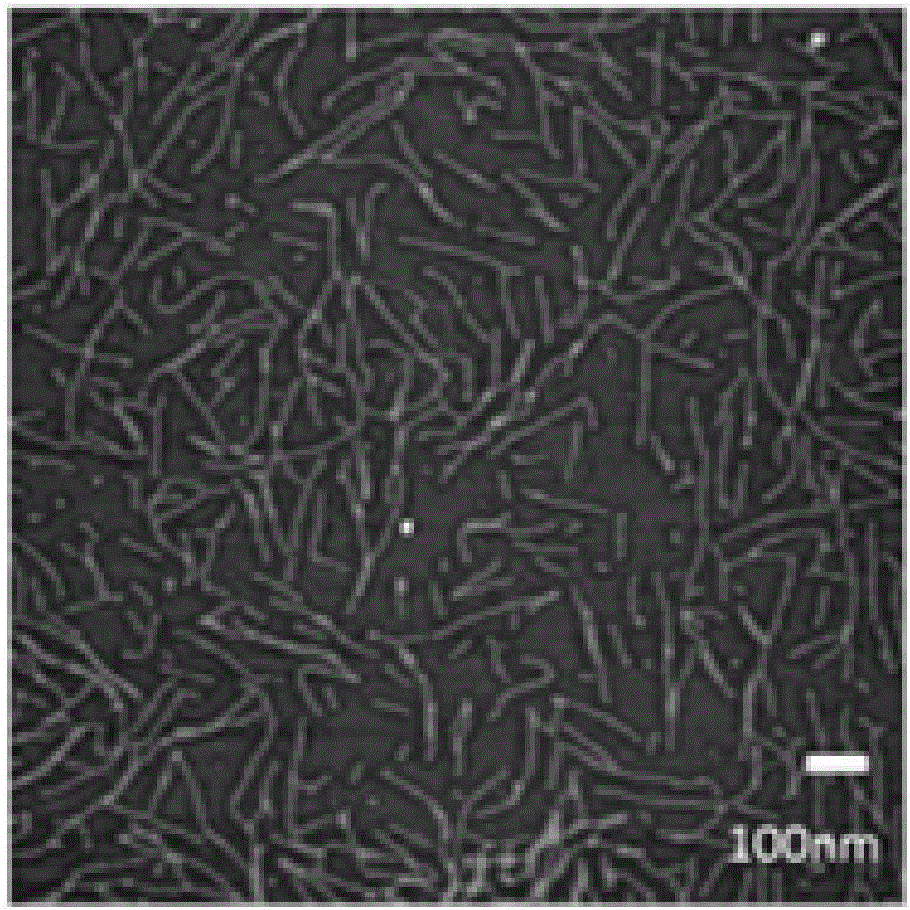Method of assembling nano necklace based on DNA nanoribbon templating and gold particles
A technology of gold nanoparticles and gold particles, which is applied in the field of detection and analysis, can solve the problems that DNA nanobelts have not been used to assemble gold nanoparticles, and achieve the effects of precise space addressability, high formation yield, and simple structure
- Summary
- Abstract
- Description
- Claims
- Application Information
AI Technical Summary
Problems solved by technology
Method used
Image
Examples
Embodiment 1
[0047] For the convenience of those skilled in the art to further understand and implement the present invention, the following relevant examples are now provided: Embodiment 1: About how to prepare 20nm gold nanoparticles
[0048] (1) Place the chloroauric acid solution with a mass fraction of 1% in a three-necked flask with a lid, stir and boil in an oil bath (150° C.);
[0049] (2) To the solution in step (1), add sodium citrate with a molar concentration of 40mmol / L, boil and vigorously stir for 10min to make the solution evenly mixed;
[0050] (3) Turn off the heat source, stir vigorously for 15 minutes, the solution turns from yellow to red, and let stand until room temperature;
[0051] (4) After the reaction is finished, the solution obtained in step (3) is concentrated by centrifugal purification, and the centrifuged product is dispersed into ultrapure water.
Embodiment 2
[0053] Example 2: About the preparation of gold nanoparticles modified by ssDNA1
[0054] Take 150 μL of gold nanoparticle solution in Example 1 to prepare ssDNA1-modified gold nanoparticles:
[0055] (1) Wash 150 μL of the gold nanoparticle solution by centrifugation once, centrifuge at 9000 rpm for 10 minutes, and disperse the centrifuged product into 100 μL of ultrapure water;
[0056] (2) Add 5 μL of 100 μM ssDNA1 to the solution in step (1), and at the same time add 1.5 μL of 1% sodium dodecyl sulfate solution, oscillate and mix, and place at a temperature of 37°C and a rotation speed of 250rpm constant temperature shaker, shake and incubate for 4 hours;
[0057] (3) Add 2 mol / L sodium chloride solution dropwise to the solution in step (2), add 2.5 μL each time, and add dropwise 4 times at an interval of half an hour. A constant temperature shaker at 250rpm, shaking and incubating for 8h;
[0058] (4) After the reaction in step (3), the gold nanorods modified by the ss...
Embodiment 3
[0061] Embodiment 3: About the assembly method based on DNA nanobelt template gold particle
[0062] (1) The DNA backbone chain (nanoribbon-scafford) with a molar concentration of 4 μmol / L and the single-strand staple (nanoribbon-staple1, Modificatory nanoribbon-staple1, nanoribbon-staple2, nanoribbon-staple3, Modificatory nanoribbon-staple3) were mixed in equal volumes, 2 μL of each chain was taken, and 10 μL of 1×TAE-Mg buffer was added to make up to 20 μL, shaken and mixed. Then add 10 μL of the concentrated gold nanoparticle solution in Example 2, shake and mix.
[0063] (2) Place the mixed solution of step (1) in a PCR instrument and anneal at a rate of 0.1°C / 10s from 45°C to 25°C, take a newly dissociated mica sheet, drop 5 μL of the above-mentioned mixture after reaction, and dry it. The atomic force microscope was used for characterization, and the characterization results are shown in image 3 and Figure 4 .
[0064] From image 3 It can be seen that the yield o...
PUM
| Property | Measurement | Unit |
|---|---|---|
| Length | aaaaa | aaaaa |
Abstract
Description
Claims
Application Information
 Login to View More
Login to View More - R&D
- Intellectual Property
- Life Sciences
- Materials
- Tech Scout
- Unparalleled Data Quality
- Higher Quality Content
- 60% Fewer Hallucinations
Browse by: Latest US Patents, China's latest patents, Technical Efficacy Thesaurus, Application Domain, Technology Topic, Popular Technical Reports.
© 2025 PatSnap. All rights reserved.Legal|Privacy policy|Modern Slavery Act Transparency Statement|Sitemap|About US| Contact US: help@patsnap.com



